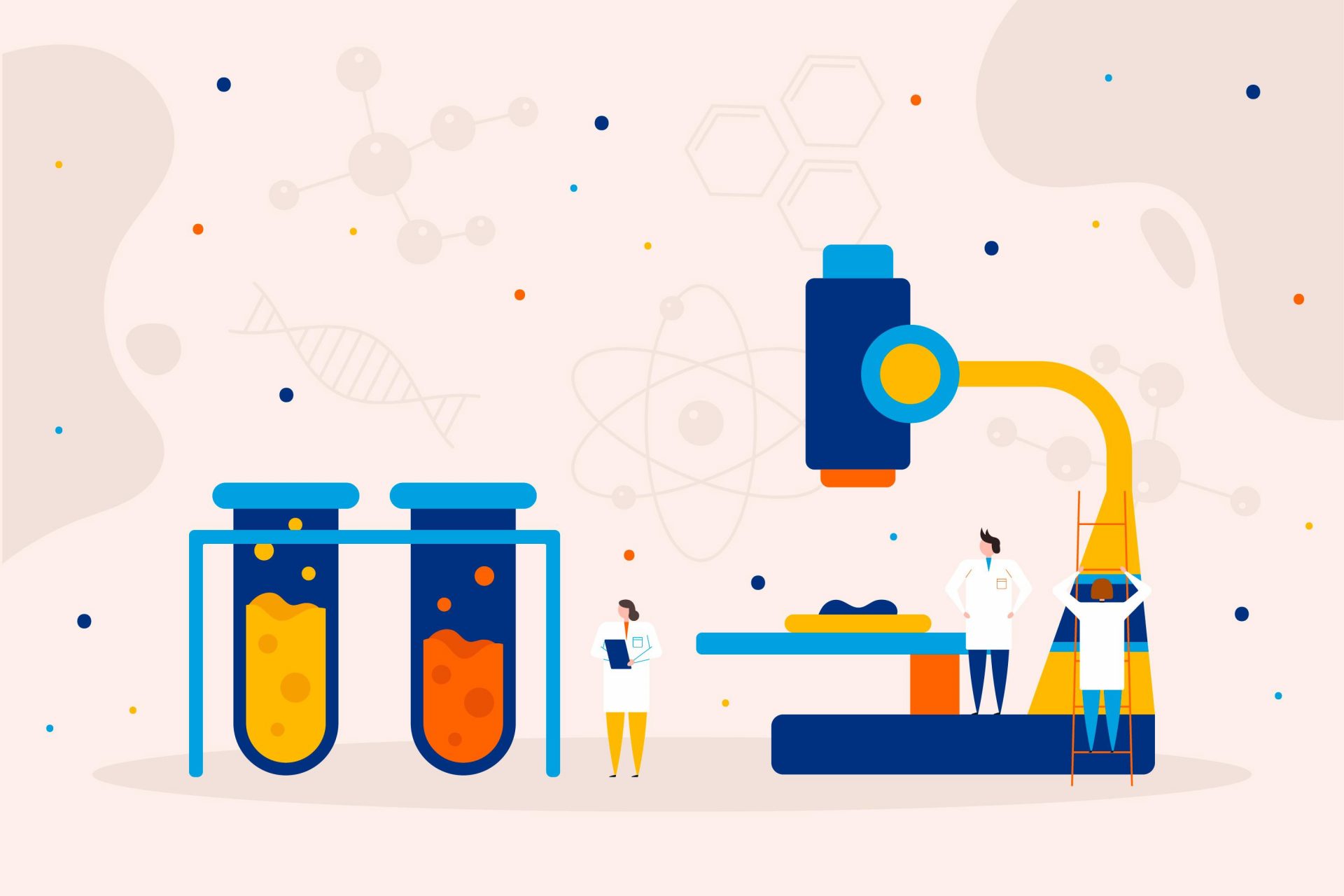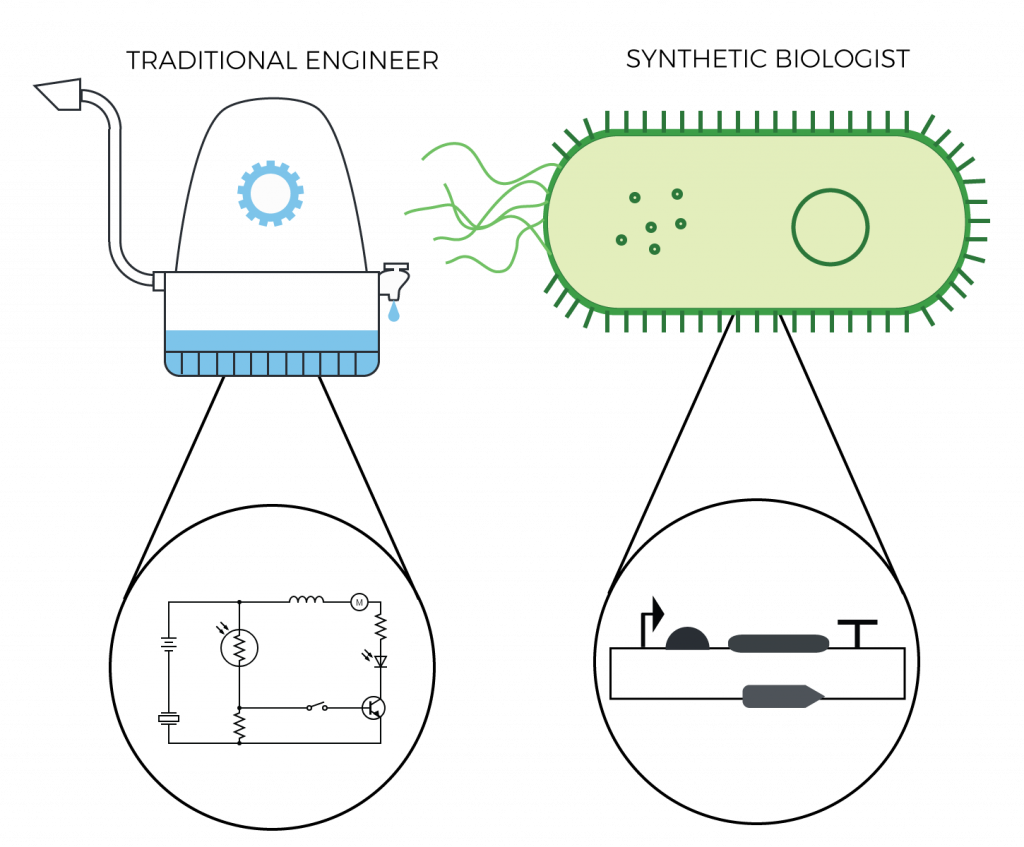
Synthetic Biology, Explained.
You’ve probably heard of synthetic biology before. Although there is no widely accepted definition of synthetic biology, it is commonly introduced as an interdisciplinary field that applies engineering principles to biology.
But what actually is synthetic biology, what do synthetic biologists do, how does it work, what are its applications, what are its consequences?
Machines are all around us; cars, computers, elevators, vacuum cleaners, the list goes on forever. Over the last 300 years, engineers have developed many machines, which led to a “boom” in human development. However, these machines made by humans aren’t the only ones on earth; the most abundant, versatile, and complicated machine is often overlooked. LIFE! Humans actually aren’t the best engineers in the world, nature is. Millions of years of evolution have led to a versatile, capable, and adaptive selection of living organisms.
Simply put, synthetic biology is an interdisciplinary field that applies the principles of engineering to these living machines nature has provided to solve problems. It uses life as a tool to create biological systems that have useful purposes. A traditional engineer’s and a synthetic biologist’s approaches to a problem are the same, the tools they use are what separates them. A traditional engineer would use gears, springs, and circuits, whereas a synthetic biologist would use microbes, proteins, and gene circuits. For example, limited access to clean drinking water is a present and growing problem in third world countries. A traditional engineer will likely design a machine with various compartments that purify dirty water by applying physics laws. Whereas a synthetic biologist will modify or create organisms to carry out the task of cleaning water.

But, why use synthetic biology when we are already so good at making machines out of metal and polymers? It may seem that the potential of machines made of polymers, metal and silicon is much more significant when compared to carbon-based living machines. But directly comparing the two doesn’t do synthetic biology justice as the two circumstances are very much different. Humans have created metal and silicon-based machines, improved them throughout the years, and know how they work, what they do, and what their potentials are. As a result, it is much easier to manipulate them to perform specific tasks. On the other hand, we did not create biology, we found it. We don’t even fully understand it yet, let alone be able to create it. Only recently, in the last few decades, we have begun to realize the potential of living machines. Scientists are now able to manipulate and modify existing pathways for humanity’s benefit. However, creating functional pathways from scratch remains an extremely difficult task. Nevertheless, it is only a matter of time until we can easily create entire pathways or even entire organisms optimized to perform specific tasks.
Synthetic biology relies on the creation of biological systems either from scratch or by modifying and combining already existing systems. It achieves this by manipulating DNA, the “blueprint” of life. Biological systems consist of proteins, and proteins are encoded by the DNA. Manipulating the DNA leads to the manipulation of the proteins and can result in modified systems. Assemblies of DNA that encode the biological systems are called “genetic circuits.” Genetic circuit components such as promoters and repressors can be combined to create logic gates similar to ones existing in computers. The more complex circuits, the more precise the control. In fact, scientists at MIT have developed a programming language written on a computer and gets compiled into DNA, which is then put to cells to be run.1_iBiology Techniques. (2020). Synthetic Biology: Programming Living Bacteria – Christopher Voigt. [Online Video]. 5 January 2016. Available from: https://www.youtube.com/watch?v=lNttxYdGHs4. [Accessed: 29 June 2020]. By using genetic circuits, synthetic biologists can program various systems into living cells, which can be used for multiple purposes.
Synthetic biology can be used to tackle many problems; its applications are vast. The current synthetic biology applications can be grouped under 6 major sectors: diagnostics, therapeutics, energy, environment, food, and manufacturing. Microbes have been engineered to sense and treat various diseases and disorders. For example, researchers at the J. Craig Venter Institute are working on engineering probiotic bacteria which can sense increasing glucose levels and secrete insulin for diabetic patients.2_J. Craig Venter Institute. 2017. No More Needles! Transforming the Treatment of Type 1 Diabetes. [ONLINE] Available at: https://www.jcvi.org/research/no-more-needles-transforming-treatment-type-1-diabetes#. [Accessed 29 June 2020]. Synthetic biology is also being used to combat climate change. A company based in the US aims to suck the carbon out of the atmosphere using engineered bacteria and create biofuels from the carbon.3_Lanzatech. 2019. Lanzatech. [ONLINE] Available at: https://www.lanzatech.com/.[Accessed 29 June 2020]. Living machines can also be used to sense and degrade pollutants in the environment, to produce products commercially, to create food, and much more. These applications are merely the ones that have already been attempted. With the deepening of our understanding of biology comes the more effective manipulation of it. In the future, we may use synthetic biology to cure cancer, construct buildings, improve computers, colonize planets, and even become Spider Man. The possibilities are endless!

Synthetic biology has the potential to propel humanity forward substantially. Living machines are cheap, robust, and powerful tools with many potential applications, both in daily life and industries. However, as a friendly neighborhood Spider Man once said, “with great power comes great responsibility.” The usage of synthetic biology as a tool may have unintended consequences. There are controversial synthetic biology applications that come with many ethical considerations like bringing back extinct species, creating interspecies chimeras, designer babies, etc. Each of these applications isn’t intended to do any harm. Still, there is a magnitude of parameters to consider before carrying them out. They may have unforeseeable consequences; thus, they are avoided. For example, bringing back dinosaurs could result in severe disruptions in food chains resulting in collapses of ecosystems. Attempts at creating interspecies chimeras can result in the creation of suffering, non-viable beings, which is extremely unethical. Tampering with the human genome to create designer babies can result in unintended changes that can lead to death or genetic diseases and disorders. Before considering attempting such dangerous experiments, the potential risks must be found and minimized. Synthetic biology can also be used with the intention of harm. It may be used to create a deadly pathogen as a bioweapon that can wipe out entire populations and species. This can lead to the collapse of ecosystems or even the entire biosphere as species and ecosystems are dependent on each other. By targeting industries, synthetic biology can also be used to disrupt production chains and inflict economic damage. Synthetic biology is a potent tool; though it has the potential to do good, it can also have adverse side effects and be weaponized.
The field of synthetic biology is growing exponentially. With the discovery of cheaper and easier DNA sequencing and editing tools, synthetic biology is gaining more and more attention. A few decades ago, it took the entire world 13 years and 2.7 billion dollars to sequence the human genome. Today an equipped laboratory can do this in a few days and 2-3 thousand dollars. In the future, people may be able to sequence entire genomes in their basements for less than 10 dollars. The rapid development of synthetic biology tools broadens what can be done with biological engineering. Similar to the leaps in human development caused by the industrial revolution and popularization of conventional machines, synthetic biology may allow humans to retake significant jumps in the future. Who knows, maybe a genetic or biological revolution is upon us. Synthetic biology is a promising tool that may solve some of the world’s most substantial problems like climate change, cancer, and world hunger. However, synthetic biology can also be used for malicious purposes leading humanity to a dystopic future if it is misused. This shouldn’t shy us away from synthetic biology; it must be used cautiously in a controlled environment, keeping in mind ethical and social concerns. Nonetheless, it is exciting to think about what the future holds for synthetic biology; I suspect great things…
*Featured image credit: Science vector created by freepik
References [ + ]